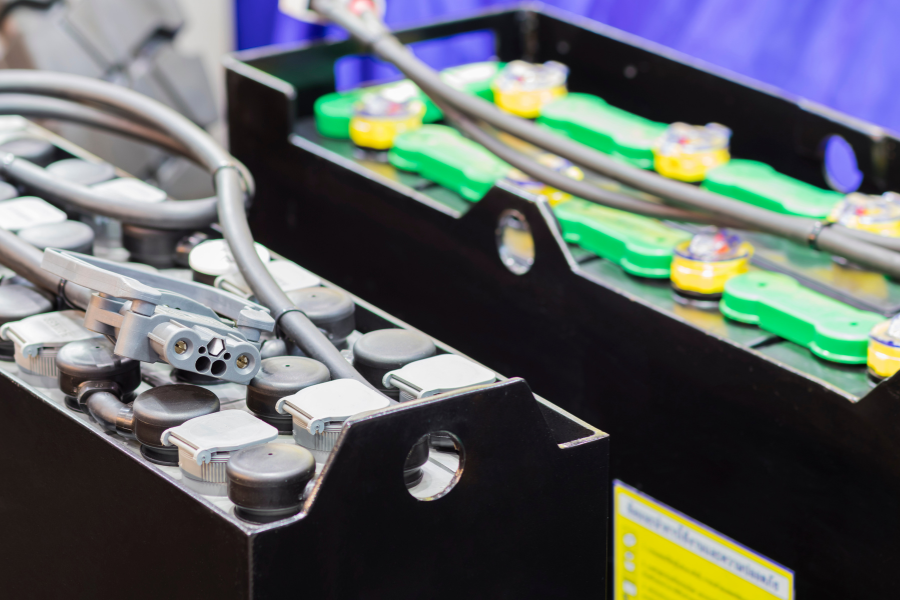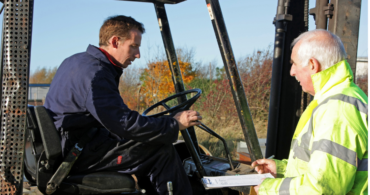If your forklifts are powered by lead-acid batteries, you want to get the most from your batteries to ensure longevity and performance. However, there is a condition that can significantly degrade a battery’s performance and lifespan: sulfation. One way to keep your batteries performing their best is with a battery equalization charge.
An equalizing battery charger can help reverse sulfation and keep your forklift batteries operating at peak performance.
Understanding sulfation
Lead-acid batteries are one of the most popular forklift batteries (however, there are many contenders nipping at their heels). These batteries consist of lead plates immersed in an electrolyte solution of sulfuric acid. When these batteries are busy generating electricity, the sulfuric acid splits into sulfate and hydrogen atoms. Sulfate is attracted to lead, so it bonds to the lead plates, which forms lead sulfate.
Over the lifetime of a lead-acid battery, it goes through many charging and discharging cycles. The lead sulfate forms as part of the discharge cycle. When the battery recharges, the lead sulfate breaks down. This is a natural, and essential, part of the battery’s activity.
However, when a battery is undercharged or does not reach a full charge, some of those hard lead sulfate crystals can remain in the battery. Over time, the hardened lead sulfate builds up inside the battery, eventually reducing the battery’s performance. This creates a condition known as sulfation.
You can’t see the damage of sulfation without opening a battery. However, some common performance issues that indicate battery sulfation include:
- Reduced runtime.
- Longer charge times.
- An inability to hold a charge.
- Difficulty starting the forklift.
- Low battery voltage.
- Poor performance in cold weather (colder conditions already reduce a battery’s capacity; when combined with sulfation, the performance can be further compromised).
- Corrosion (sulfation can cause internal battery components to deteriorate, which allows acid to leak).
- Bulging or swollen battery case (this indicates severe sulfation; a swollen battery cannot be repaired and must be replaced).
If left unchecked, sulfation will cause the battery to fail. It’s not always possible to reverse battery sulfation. However, if caught before the damage is too extreme, the best way to counteract sulfation is with an equalization charge.
What is equalizing a battery?
An equalizing charge applies a carefully controlled overcharge to a battery. A battery charger with equalization mode typically uses a slightly higher voltage than the battery’s standard charging voltage. This extended charging process helps break down and dissolve the lead sulfate crystals, allowing the battery to recover its capacity and performance.
How to equalize batteries
Begin by ensuring that you have a charger with the capacity to equalize charge. That may seem obvious, but not all chargers have this capability. Be sure to follow the manufacturer’s recommendations when performing an equalizing charge.
An equalization battery charger is a specialized type of charger designed to reverse sulfation and maintain the health of lead-acid batteries. Unlike a standard charger that provides consistent voltage to recharge a battery, an equalize battery charger employs a multi-stage charging process.
The multi-stage charging process of an equalization battery charger typically consists of three main stages: bulk charging, absorption charging and equalization charging.
- Bulk charging: the charger delivers a high current to quickly bring a battery to a specified voltage level.
- Absorption charging: once the battery voltage reaches the specified voltage level, the charger gradually reduces the charging current as the battery approaches full capacity, allowing the battery to safely reach a full charge.
- Equalization charging: Our favorite phase and the point of this article; during equalization, the charger applies a controlled overcharge to the battery at a higher voltage than standard; this helps break down the lead sulfate crystals that have formed on the battery plates, effectively reversing the sulfation process.
The equalization charge also balances the individual cells within the battery, which helps to ensure uniform battery performance.
An equalization battery charger is equipped with several safety features, which typically include temperature sensors, voltage regulators, current limiters and an automatic shutdown mechanism. A battery equalization charge is a delicate operation that could be dangerous if performed incorrectly. That’s why an equalization battery charger typically utilizes several microprocessor-controlled charging circuits and sophisticated algorithms to monitor the voltage, current and temperature throughout the charging process and ensure a safe and effective equalization without damaging the battery.
Since an equalizing charge can take up to 12 hours, many businesses choose to equalize their batteries overnight or during the weekend.
Benefits of an equalization battery charger
A battery charger with equalization mode provides several benefits, including:
- Extended battery life: reducing sulfation leads to reduced maintenance (which includes reduced maintenance costs) and the need for fewer battery replacements.
- Improved performance: equalization helps maintain a battery’s capacity, which maximizes its efficiency.
- Reduced downtime: by improving performance, equalization helps prevent failure and extends a battery’s life.
- Cost savings: an equalization battery charger may cost more than a standard charger; however, the long-term cost savings from less maintenance and the extended battery life typically outweigh these upfront costs.
- Environmental benefits: even though it’s possible (and advisable) to recycle many lead-acid battery components, it’s always environmentally preferable to keep these batteries working as long as possible.
Preventing battery sulfation
The only way to prevent sulfation is by creating a routine battery maintenance schedule that follows proper charging procedures.
Texas Motive Solutions can help with our preventive maintenance program. During convenient, regularly scheduled visits, we address all forklift battery issues before they become problems, so you can avoid battery sulfation, keep repair costs in check and help protect the safety of your forklift fleet and warehouse staff.
We also offer our complimentary forklift fleet performance analysis that checks to ensure that you’re utilizing the best forklift batteries and accessories for your fleet’s needs. Please, give us a call at (888) 316-2459 or fill out this form to learn about our services and discover everything we can do for you.


